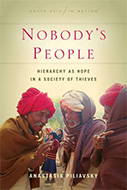Nobody’s People: Hierarchy as Hope in a Society of Thieves

Author: Anastasia Piliavsky
Publisher: Stanford University Press, 2020. 300 pages.
Reviewer: Surinder S. Jodhka | September 2022
The subject of ‘hierarchy’ occupies a special place in the sociology and social anthropology of South Asia, particularly in the scholarly literature on caste. Though the term has its origins in European Christianity, it came to be seen as a useful prism for understanding the vertically divided and simultaneously integrated, presumably “unique,” social universe of caste among the Hindus of India. The French scholar Louis Dumont has been the most influential and important proponent of such a view, who not only wrote a book on the subject of caste and describing it as a system of ‘homo hierarchicus,’ but also contrasted it with the modern culture of the west (Dumont 1971). Hierarchy, for Dumont, was not merely about inequality of material possessions and power, as it was understood in the modern west. On the contrary, it was a valued attribute among the Indians/Hindus, deeply embedded in their religious faith and cultural practices. Indian culture was, thus, fundamentally different from the modern west and could/should not be approached using categories such as class. Instead, status and ritual hierarchy encompassed everything else in the Hindu social life.
After its Independence from the British colonial rule in 1947, India chose to become a modern nation as a liberal democracy. Its Constitution imbibed most of its foundational values from the modern West, foregrounding democratic citizenship and bestowing equal rights to all individuals, irrespective of caste, creed and gender. Though it did not outlaw the practice of caste, its new leaders assumed that economic growth and democratic politics will slowly make it redundant. Over the decades, a new ‘hegemonic middle-class’ has emerged in urban India, with ideas of individual achievement through education and hard work. Individual aspirations in modern India are presumably shaped with reference to such a middle-class status.
Anastasia Piliavsky begins her monograph by questioning the validity of such a claim. Hierarchy continues to be the foundational value, almost everywhere, she asserts. Though the electoral politics system has come to be institutionalised at different levels, hierarchy remains the underlying normative practice in India’s political life. Invoking her extensive ethnographic fieldwork in the western Indian state of Rajasthan, she claims that her ‘Indian hosts and interlocutors had not traded their own vision of life for the one inscribed in the Indian constitution by its (anglophone) founding fathers, or for agendas of international organizations or NGOs, or for urban middle-class aspirations. They had not come to regard their own way of seeing and being in the world as an obstacle to living well. On the contrary, and unsurprisingly, it was their structure of hope’ (p. xxvii).
Piliavsky draws her core arguments from her ethnographic work among the community of Kanjars who have traditionally pursued thievery as their occupation. Given their position, they apparently lived outside the system of caste hierarchy and the associated structures of patronage. However, that was not entirely true. Many among them had their patrons among the rulers/kings and those from the dominant castes. The British rulers listed them as one among the ‘criminal tribes.’ They were ‘de-notified’ by the Indian government after independence. Kanjars were included in the state list of the Scheduled Castes. However, as the author claims, their ‘way of seeing and being’ has not changed, and they continue to position themselves in relation to their patrons. It is this culture of patronage that reflects the persistence of hierarchy. Even individual aspirations are seen to be achieved through these relations of patronage and loyalty.
To give more empirical weight to her claim, she extends her fieldwork beyond the Kanjars and explores practices of electoral democracy, the process of getting elected in the Indian electoral system, and evidence to show that patronage seems to matter everywhere. She states that, ‘patronage was the basic measure of status and respectability, of social worth. Its idealized form framed expressions of social hope and its failure in actual life were the source of its bitter disappointment’ (p. xxxii).
However, the core of her book is not the ethnographic account of the Kanjar community, the challenges it confronts in the rapidly changing India, or even the workings of electoral democracy in rural and small-town Rajasthan. She argues, quite forcefully, for recognition of hierarchy as a valued practice in modern day Indian life, including in its democratic political life. More importantly, she does not confine her argument to the empirical context she is engaged with, but wishes to extend it to all of India. She finds claims by urban NGOs of democratic empowerment of the poor and marginalized through practices of citizenship to be pretentious and misplaced: India is unique and its poor love hierarchy and patronage! Citizenship and egalitarianism are alien western ideas, superimposed by the urban elite, she argues.
Piliavsky is obviously not the first one to make such a claim. This is an old orientalist trope. Louis Dumont had turned it into a theory of the Indian caste system with hierarchy and holism as its core elements. She is obviously aware of this and admits that her work is located within the Dumontian tradition. However, she also attempts a revision of Dumont by taking ‘holism’ out of the conception of hierarchy. She recognizes the rise of ‘individual aspiration,’ but visualised within the channels of hierarchy and patronage.
While there is certainly an element of truth in her empirical claims, her theoretical generalizations are problematic and may be too ambitious. While ascription-based hierarchies indeed persist in India, even in its urban corporate economy (see Jodhka 2015; 2016), they are not celebrated, certainly not by those at the receiving end of such discriminatory practices. Hierarchy, for them, is violence. Structurally speaking, it has always been so. The practice of untouchability is an obvious example of this.
How do we make sense of the rise of Ambedkarite politics and the ‘silent’ (Jaffrelot 2003) and not so silent revolutions/revolts of those traditionally located on the margins of Indian society and its caste system? Indian farmers sat on the borders of Delhi for a year demanding to be consulted while framing policies on agriculture. This has been one of the most powerful and effective democratic political movements, comparable to any other movement for social democracy and citizenship anywhere in the modern world (see Jodhka 2021).
There are many Indias with varying cultures and histories, including differences in structures of caste hierarchy. Like the rest of the world, the South Asian region too has had history, with significant changes emanating from within. A singular narrative might sound an interesting theoretical construct or a proposition, but it does injustice to the diverse realities of a vast social universe, currently organized as a nation-state. Available empirical accounts present a far more complex picture of the realities of India than what has been suggested in Piliavsky’s theoretical propositions.
References
Dumont, L. (1971). Homo Hierarchicus: The Caste System and its Implications. Oxford University Press.
Jaffrelot, C. (2003). India’s Silent Revolution: The Rise of Low Castes in North Indian Politics. New Delhi: Permanent Black.
Jodhka, S. S. (2015). Caste in contemporary India. New Delhi: Routledge.
Jodhka S. S. (2016) ‘Ascriptive hierarchies: Caste and its reproduction in contemporary India’. Current Sociology (Monograph) Volume 64 (2): 228-43.
Jodhka, Surinder. 2021. ‘Why are the Farmers of Punjab Protesting?’ Journal of Peasant Studies 48 (7): 1-15.
Surinder S. Jodhka is a professor at Jawaharlal Nehru University.


